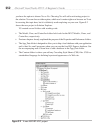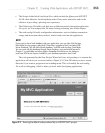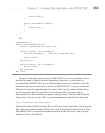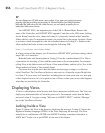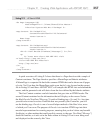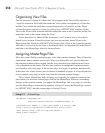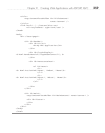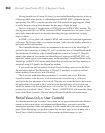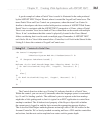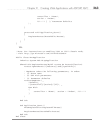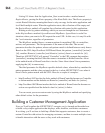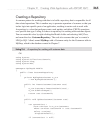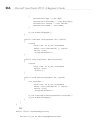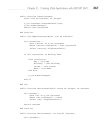
260 Microsoft Visual Studio 2010: A Beginner’s Guide
Moving from the top of Listing 9-3 down, you can see the MasterPage directive at the top
of the page, which states that this is a MasterPage and ASP.NET MVC will handle the page
appropriately. The DTD is a tag that specifies what Web standards this page supports, which
is read by browsers to help them determine the best way to display the page.
The rest of the page is framed inside of HTML tags and ASP.NET MVC markup. The
html tag states that this is an HTML document. HTML documents have two parts, a head
and a body, where the head is for metadata describing the page and the body contains
display content.
In HTML, a div tag blocks off a chunk of HTML and is useful for layout and organization
of the page. The Hx tags, where x is a number between 1 and 6, describe headers, where h1 is
the largest and h6 is the smallest.
The ContentPlaceHolder controls are instrumental to the success of the MasterPage. If
you look at the Content tags in Listing 9-2, you’ll see that they have a ContentPlaceHolderID
that matches the ID attributes of the ContentPlaceHolder controls in Listing 9-3. What this
means is that when the View renders, the MasterPage will display and ASP.NET MVC will
inject the Content regions of the content pages into the matching ContentPlaceHolders of the
MasterPage. ASP.NET MVC knows which MasterPage to use because the Page directive, as
shown in Listing 9-2, specifies the MasterPage attribute.
If you recall from the last section, Listing 9-2 had a binding expression for the Html
Encode helper method. The MasterPage in Listing 9-3 introduces a couple more Html
helper methods, RenderPartial and ActionLink.
The ActionLink method has three parameters: id, controller, and action. When the
ActionLink renders in the browser, it will transform into an anchor tag, a, with an id
specified in the first parameter of ActionLink. When the user clicks the link in the browser,
the application will navigate to the Controller in the third parameter of ActionLink and
invoke the action in the second parameter of ActionLink. So, if the user clicked the link
produced by ActionLink("About", "About", "Home"), ASP.NET MVC will invoke the About
action of the Home Controller. The next section discusses RenderPartial in more detail.
Partial Views (a.k.a. User Controls)
It’s often the case that you’ve written View content on one page and need the same identical
content on two or more pages. As explained with MasterPages, you want to avoid the
maintenance work that comes with updating all of the content that is the same on multiple
pages. While MasterPages are good for content that decorates pages across an entire site, a
Partial View is ideal for limited reuse of View content on different pages of a site.



